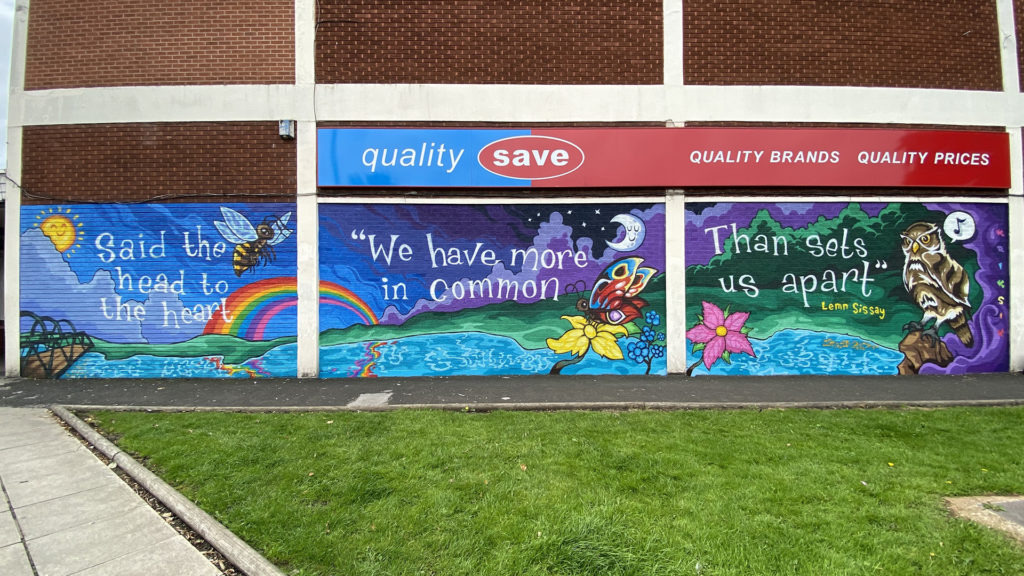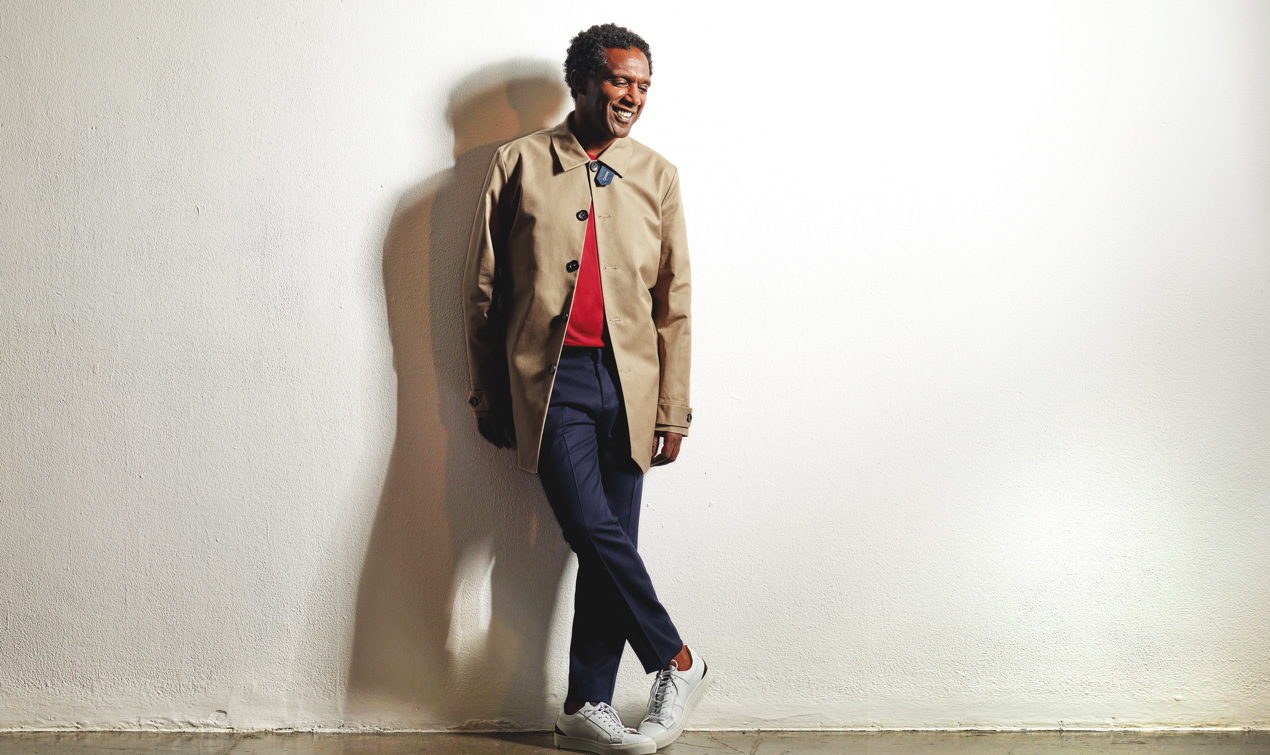I’m waiting in Manchester on the other end of a phone line as Lemn Sissay is stopped on the streets of east London for the second time in 15 minutes.
“That’s a guy that keeps stopping me and going ‘I know you from somewhere,’” he says afterwards, with what sounds like a smile on his face. “Can I tell you what it is? He’s seen me on telly. The last time he did it he said ‘I know you from somewhere’ then, as well. I can’t just say to him: ‘I was on telly last night.’”
Sissay has spent almost his entire adult life battling to prove his existence. Stolen from his mother, fostered as a baby by a couple who would later have him packed away to a children’s home, and then denied the records of his life by Wigan Council for three decades, the poet’s energies were for so long focused on his fight to be seen and heard.
“I am aware that I’ve put out so much of my own story that I feel that it’s part of my responsibility to answer questions,” he says when I ask how it feels to go over the details of his life so often. “Every time somebody recognises my story and asks a question about it, they acknowledge it – that it happened. The whole story is about it not being acknowledged, and so it is a wonder. It never gets old because it’s like being seen, and for someone who was so invisible the act of being seen is joyous.”
Following his 2018 case against Wigan Council that was settled with a six figure payout and a formal apology for the treatment he suffered when in care, the publication of his stark memoir My Name Is Why in 2019, and a BBC documentary with Alan Yentob that aired this summer, he now has a face that people recognise. He’s stopped a lot.
“I like people,” he says “I like being stopped randomly. In Manchester, it’s great. In Manchester it used to be taxi drivers saying: ‘All right, Lemn!’ It’s nice when it happens. It happens a lot in London. Ethopians stop me. I never feel like anybody’s imposing on me by asking.”
When we speak, Sissay is on the move, the sounds of the city all around him. The capital is where he spent all of lockdown.
“I’ve never been home for this length of time in my adult life,” he says. “I’ve loved it. I have a suitcase packed just to go anywhere, you know, to gigs. That is how our life is. Travel, hotels, planes, automobiles, stage – ta daaa! And so I think I’m all right with not doing both of those things, surprisingly.”
As a teenager he was so desperate to escape to Manchester that he walked there barefoot. Does he now feel at home in London?
“Home is definitely something that you have inside yourself, so wherever I am I can feel at home. That’s how it’s worked out for me, weirdly.
“For me, home is just the ability to feel safe, to feel like you don’t have a fight or flight thing going on in your head, just being allowed to be unstressed.”
The pandemic has given him a chance to “take stock” of what he’s doing and where he’s going. He’s even quit smoking, he says gleefully, a habit the 53 year old picked up aged just 11 and a half.
“It was one of the reasons that the family put me into care. They saw it as a rebellion against them. I went into children’s homes and they don’t stop you smoking so you have smoking breaks and smoking was part of what it was to be in care at 12 years of age. I’ve smoked ever since. There’s a lot attached to it.”
And although he’s found time to reflect, there’s no sense that the global pandemic or the cancellation of his live events have slowed the broadcaster down. This summer has brought the release of the My Name Is Why paperback, the airing of the Imagine… documentary, judging the Booker Prize and plans for his annual Christmas Dinner project, which provides a Christmas Day for care leavers.
He’s also been a judge on the Hold Still photography awards, spearheaded by the Duchess of Cambridge and focusing on images that captured the nation’s response to the coronavirus outbreak. Sissay helped whittle down more than 31,000 submissions to 100.
“We have been through a unique collective experience that is filled with individual moments of triumph and loss, of community and loneliness,” he says of the project, which sits on the National Portrait Gallery’s website. “All of the extremes have happened to us throughout this pandemic and often the photograph captures what we have lost; the camera connects what cannot connect.”
The pandemic, he says, has made clear that the arts are a “great translator of the human spirit”, and that poetry has never been as popular as today. The reason?
“Because of the great publisher in the sky, the internet! That’s why a whole lot of things are happening. That’s why #MeToo is happening, that’s why Black Lives Matter is happening – because people can communicate what is going wrong very quickly and they get it and they agree with it and therefore it’s a revolutionary tool and whenever there
is revolution there is poetry.”
His own poetry, he says, was a way to better understand himself.
“Poetry allowed me to translate what had happened or what was happening in a way that spoke to me. Poetry is my friend.
“As you grow through life, your friendship is kaleidoscopic. At different times of your life, it will have different colours. I think poetry is like that – sometimes it’s very close to me and sometimes it’s not.”
Despite his heartbreaking story, Sissay believes painful experiences are universal.
“I don’t feel like I’ve had it any worse than anybody else. All of our experiences are opportunities for us to understand and care for each other. They’re bridges, you know? Our experiences are bridges to each other. If you know what it’s like to be hurt then you will learn, if you’re lucky, how not to hurt others because you have a greater understanding of pain. It is not the case that if you had a bad experience that you will exact that experience on other people.”
But being willing to work through trauma is hard work. Did he ever consider not reading his files from his time in care, to avoid the pain?
“Oh god yeah. It’s distressing. Reading the files is really difficult. Reading the files is not an easy thing to do.
“One of the things that lots of people say is that they can’t, they don’t want to, they can’t because it’s too emotionally difficult. I felt the same, which is why making them public is really helpful because it takes away their power.
“A lot of institutions that want to control us need us to feel isolated. If we feel isolated, we feel less powerful. We don’t have the collective power so we
are more likely to not call the institution to account.
“This is why we need to track mental health services, we need to look at what happens when people are sectioned. As soon as you can isolate a human being you can do all kinds of things to them and institutions can do that to a human. All kinds of institutions – schools, social services, policing, housing – the more isolated we are the less likely we are to do anything about it. The first act of independence is asking for help and help from your fellow people who are in similar situations.”
Sissay gets home to a delivery of a wooden table top. “You can call me back!” he says, as he hangs up to carry it inside. When we reconnect, I have just two questions left.
Firstly, what is he working on?
“I’ve got a children’s book I’m working on with Canongate Books, I’m working on setting up my second book, the follow-up to My Name Is Why, some TV, I’ve got some radio docs coming up. Just one day at a time man! You’ve never made it. I do what I love and I’m lucky, aren’t I? So I need to appreciate it.”
And in a world that feels like a dystopian novel, what makes him hopeful?
“It’s the generation of people who are not taking no for an answer and who are rising up against injustice and who are articulating a better world.
“I’ve lived a lot but I’m watching a generation of people now articulating themselves into better human beings and that means a better society. That means we have to – that’s my generation – have to listen to their generation. And they will make mistakes but then so did we and that’s okay. We need to support them through that.
“I feel lucky to be in the world today. It’s a much brighter place than the one that I grew up in and it’s because of the changes in our society that I’ve been able to write My Name Is Why. We are outing the files of the past so that we can prepare for a better future.”
Main photo: Hamish Brown
Over the wall

Walk through Manchester’s streets and it won’t be long before you find a piece of art inspired by Lemn Sissay.
The poet’s words have been placed above Gemini Takeaway on Oxford Road, on Hardy’s Well pub in Rusholme, even right under your feet on clay blocks in the Northern Quarter.
Most recently, Sissay’s work has found a new home, on the side of Chorlton Precinct.
Commissioned as part of Chorlton High School’s online Beelong Festival, the new spray-painted piece features the verse:
Said the sun to the moon/Said the head to the heart/”We have more in common/Than sets us apart”.
Artist and Manchester resident Sumit Sarkar was tasked with bringing the words to life, taking inspiration from the local community, nature and the poem itself.
“We came up with a few ideas, including a couple that were quite leftfield,” he says. “We decided on something not complicated, enjoyable and just pleasing. The focus lent quite strongly on Lemn’s poem.”
Sarkar completed the mural over a number of weeks – he estimates a total of nine days worth of work.
“It was just such a powerful poem,” Sarkar says. “When I was working on it I was probably stopped every 10 minutes by Chorltonites saying that they loved the work, which was really nice.
“When I was mid-painting I was repeating the full poem quite often and it just hit me and hit whoever I said it to because it’s so beautiful and resonant of now.
“We’ve had an awful summer on all fronts and it was just a really powerful, positive message. It felt right that the words were the main part of the mural.”
Like the Big Issue North on Facebook




Leave a reply
Your email address will not be published.